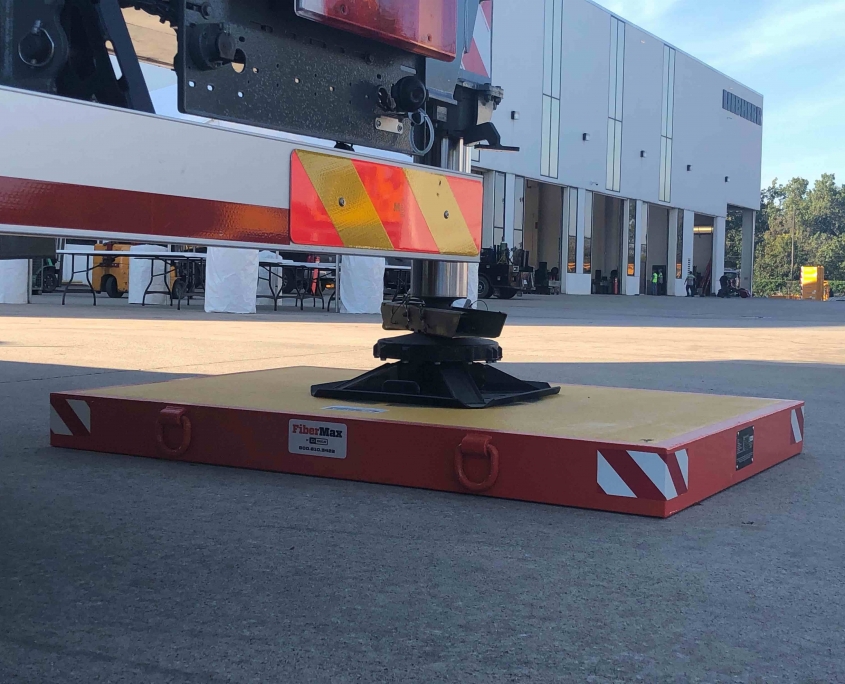Hard Ground Setups
Many of our customers are facing ever more stringent requirements for reduced ground bearing pressures. This may be due to greater regulatory attention on equipment setup, or site owners who are more risk-averse to unknown ground conditions, or a lack of understanding of how crane pads and mats distribute load. When working in very hard ground conditions with strict load reduction requirements, using an intermediate layer as a buffer can help you get optimum performance out of your outrigger pads or crane mats.
A common misconception regarding the load distribution of crane pads and mats is that outrigger loads are evenly distributed across the entire mat area in all ground conditions — no matter what the pad is or what the loads or pressures are from the equipment. These assumptions should not be made. To achieve even, equal, and predictable distribution over the area of the mat, an infinitely rigid material would be required. In the world we live and work in, there are no infinitely rigid materials—not even high-strength steel. Therefore, there will always be some level of peak loading, and actual load distribution will be the result of how the load, ground and pads influence each other.
From The Ground Up
Some movement and compaction of the ground allows pads and mats to deflect. Managed deflection of pads and mats improves overall load distribution because it increases the contact area between the mat and the ground. Even with engineered and properly selected outrigger pads or crane mats, some deflection is expected.
However, hard ground presents different challenges. As the ground conditions become harder or ground bearing capacities increase, pads and mats become less effective in spreading load. In very hard ground conditions such as a slab of concrete, load typically distributes at an angle of 45-60 degrees through the thickness of the pads. This results in higher peak pressures and higher overall ground bearing pressures because of the reduced area of distribution. Often the interaction between the ground and pad is not recognized or understood, which results in higher ground bearing pressures than are intended.
Simple Solutions
To reduce ground bearing pressure in very hard ground conditions, consider introducing a softer buffer layer that allows for managed pad deflection to occur. The objective is to soften the ground to make the existing pad more effective as opposed to stiffening the pad to overcome the hard ground conditions. Softening the ground is a counterintuitive approach, however making pads stiffer can significantly increase costs and weight. Commonly used intermediate buffer materials include sand, or materials with high compaction strength, such as neoprene or rubber.
Regardless of the type and construction of the outrigger pad or crane mat you are using, any of these intermediate buffers will help with improved load distribution and the achievement of lower ground bearing pressures.
Beyond softening the ground to enhance load distribution, an additional benefit of using an intermediate layer is to fill any inconsistencies or voids between the pad and the ground (think about a surface of brick pavers). Filling these inconsistencies helps to eliminate point loading on small areas of the ground, and it helps protect the ground surface under heavy loads.
Sand as an intermediate layer can be a great solution. However, subject to the loads and objectives, a two-six inch thick layer of sand may be needed. A downside with using sand is it’s messy. A cleaner option that DICA recommends is neoprene. Neoprene is available in different sheet sizes and different thicknesses. Using .75” in a single layer or multiple layers is a simple and effective solution. Because neoprene is a manufactured product, the material also has defined performance properties users can count on. These consistent properties produce predictable and measurable results. DICA recommends using a 60-durometer neoprene for this application, which will squish under these high loads but not break down.
The Proof
At DICA, we use Finite Element Analysis modeling to project actual results of different set ups. By using this technology for hard ground setups, we are able to demonstrate how significant reductions in peak and overall ground bearing pressures are achieved by adding an intermediate neoprene layer.
Figure 1 and Figure 2 FEA images reflect a quarter symmetry model. The section displayed is the upper left quadrant of a FiberMax Mega Duty Crane Pad. The grey area is the defined ground and the purple grid pattern is the Mega Duty Pad. The upper left quadrant of the 24×24” outrigger foot is located in the lower right corner of each image. In this case, the outrigger reaction force is 225,000 lbs and the ground is solid concrete modeled as having a ground bearing capacity of 40,000 psf (extremely hard, no expected movement). The colors shown indicate the pad to ground contact and associated, correlated pressures. The results indicate a reduction in the peak pressure of 35% and an improvement in overall pad to ground contact of 22%.

In Figure 1, the average ground bearing pressure is roughly 7,200 psf based on a pad to ground contact area of 78% of the pad. Figure 2 shows how the improved pad to ground contact (now 100%) reduces the average ground bearing pressure to 5,625 psf, which is the objective (225,000/40ft2 = 5,625 psf).
While the specific prescription depends on many factors, DICA has generally found that neoprene mats that are ¾ in. to 1.5 inch thick produce optimal results. At this thickness, the amount of deflection can be managed and the benefits of softening the ground are optimized.
Get Started With Your Crane Pad Solution Today!

